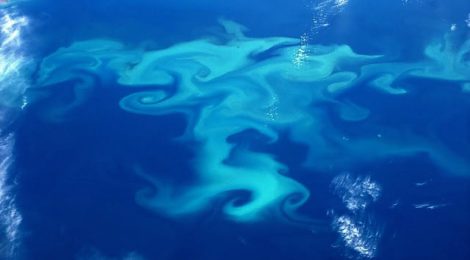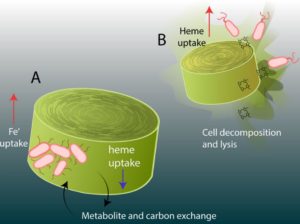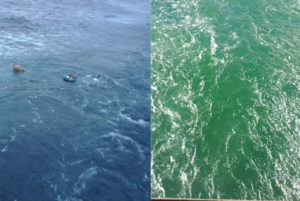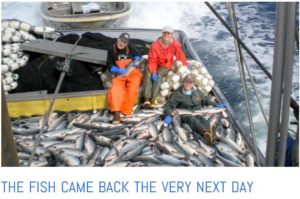
Report Confirms Iron Most Rare And Precious Sustains Ocean Life
Iron, one of the most common elements on earth, is the rarest, most precious, most vital element influencing ocean life
Iron is heavy and sinks but for ocean pastures at the surface it’s presence is matter of life or death.
Iron is the catalyst for ocean photosynthesis when available clear blue deserts return to lush blooming ‘Gardens of Eden’
A new, another, study shows how marine microbes have evolved with the direction/determination to efficiently recycle iron in a process that leaves no stone of iron unreturned.
In spite of the power of nature and evolution mankind is reducing the amount of precious iron in the oceans! We can and must remedy this human mistake.
In this new research published by the American Society for Microbiology it reveals some of the evolved molecular machinery that helps save/recycle precious iron in the surface ocean, in vital ocean plankton pastures. The researchers report this week in mSystems, an open access journal from the American Society for Microbiology, on how Roseobacter bacteria reclaim the heme molecule , an iron-containing molecule that’s widespread in the ocean, directly from algal cells that have died and are disintegrating.
The research shows that up to 90% of iron in the surface ocean ecology is recycling to sustain the system!!! Life does find a way.

Model of Roseobacter heme utilization and algal host growth. (A) During exponential growth, attached bacteria and the algal cell exchange carbon and metabolites in a mutualistic relationship. Bacteria shift their iron acquisition strategy away from heme (blue arrow, downregulation) uptake and toward other “free” iron species (red arrow, upregulation). (B) During algal cell decomposition, bacterial cells potentially transition to a motile growth phase in order to search out a new host while simultaneously targeting newly abundant heme and hemoproteins as iron resources (red arrow, upregulation).
Bacteria are the most abundant of all life in the ocean, outnumbering all other life by an order of magnitude. Eventually they consume almost everything, that is one of their roles on this blue planet. Most of what bacteria consume comes from phytoplankton, their nearest and dearest kin.
From the plankton the bacters recycle nutrients including carbon, nitrogen, phosphates and iron back into the living food web. Previous studies have analyzed the microbes and molecules that help move carbon and nitrogen through the marine environment, but the microbial processes responsible for cycling trace metals like iron have been largely unknown, says study leader and microbiologist Shane Hogle of Scripps.
This is an important missing piece of the puzzling nature of ocean ecology because iron plays the most critical role in the food web of the ocean. It empowers photosynthesis, when in short supply the ocean becomes a clear blue desert with barely any green photosynthesis to feed the ecosystem.
Studies estimate that a quarter of the total iron in some parts of the ocean is made available by recycling through bacteria. Through the natural recycling mechanism at least 50% and possibly up to 90% of iron available to surface ocean photosynthesis is kept to sustain the living ecosystem.
John Martin’s Ocean Pasture Restoration Hypothesis Confirmed
There are some people who walk apart from the madding crowds of the dull and boring. One such man in the world of ocean science was John Martin. He spent years working to unravel a Gordian Knot of complex ocean plant ecology and chemistry, the role of iron in ocean phyto-plankton.
In July 1988, during at a lecture at the Woods Hole Oceanographic Institution, oceanographer John Martin stood up and said in his best Dr. Strangelove accent, “Give me a half tanker of iron, and I will give you an ice age.”
Iron will boost or limit the growth of plankton depending on its presence which only needs to be in infinitesimal amounts measured in parts per trillion. Thirty years ago the late great John Martin showed that the oceans default iron concentration is only about 3 parts per trillion, when dust arrives and the concentration rises to 30 parts per trillion the ocean blooms.
Nothing else on this blue planet has anything near this powerful action at such low concentration. In most of the ocean which lies far from land (where iron is measured as a few percent of soil) and sediment filled river outflows, the ocean is dependent mostly on dust blowing in the wind to bring it rare and precious iron.
Microbes and man to the rescue
It is now becoming clear in part as a result of this new and exceptionally fine paper that the ocean pastures are fueled and sustained by iron that’s been recycled by microbes. This clear insight revealing details of the vital iron cycle will improve scientists’ ability to understand and mitigate the devastating chemical changes in the marine environment.
The deprivation of iron in our oceans, wrought by our CO2, over the majority of our blue planet has been leading to conversion of our once rich ocean pastures into clear blue deserts that today are incapable of sustaining the historically large numbers of fish, seabirds, whales, and all of ocean life. If we act to replenish and restore ocean iron to historic levels that have been reduced by mankind’s actions Nature will ally herself with us to multiply our good work and restore the oceans to health.
“If we want to model how the iron cycle might change under climate change, we need a mechanistic-level understanding of what’s going on right now,” says the principal author of the paper.
In a mesmerizing report (you’ll need your most powerful ‘geek goggles’ on to read it)
The scientists tell how they analyzed 153 genomes from Roseobacter bacteria, a group of microorganisms that almost always bloom along with phytoplankton blooms and are known to be important players in the marine carbon and sulfur cycles. In 69 genomes, or about 45 percent of the bacter cohort, the scientists identified a full set of genes believed to be involved in the uptake of heme, an iron-containing enzyme cofactor prevalent in marine phytoplankton, like algae. Many Roseobacter strains grow in close association with algal cells, and previous studies have suggested that heme might be an important source of iron for bacteria that live close to phytoplankton.
Subsequent experiments conducted by the researchers verified the genes’ role in acquiring heme, and further analyses of Roseobacter strains suggests that the bacteria take the heme/iron directly from lysed cells, rather than as a result of a multistep process. This bacterial process keeps the precious and rare iron from dead phytoplankton from sinking so that it can sustain the living microbial food web near the ocean’s surface.
“They inject it back into the microbial food web, instead of letting it fall out and settle at the bottom of the ocean,” says Hogle.
Bacters that can recycle heme may be slight but they are mighty, says Hogle. Recent studies on the ocean pasture carbon cycle have found that some marine bacteria that are rare in pelagic metagenomic databases become highly abundant under special conditions – and can recycle significantly more carbon than other, more prevalent clades (living parts of the ecosystem).
What’s next, or should I say what’s already begun
My life’s work is to restore and replenish dying ocean pastures that are becoming blue ocean deserts back to a condition of historic health and abundance. I’ve done this work of ecorestoration for many years, going on five decades, but my best work was done in 2012 when with 11 native friends, my dirty dozen, we replenished iron rich mineral dust to 10,000 sq. kilometers of the Gulf of Alaska in our ‘salmon restoration’ effort.

Looking astern off the transom of my research ship before we began our ‘iron’ dusting to restore the ocean to health the ocean was a blue desert. After dusting the same view revealed a beautiful emerald-green see that had become full of life. (No Photoshop, raw camera) – Click to read more
Over the course of weeks we hefted/man-handled 4,000 50 lb bags of life-giving mineral to the afterdeck from the holds of the ship to give dust back to the ocean to replenish and restore all of ocean life, from the bottom up.
This new microbiology paper reveals why my Gulf of Alaska bloom lasted so long and worked so well with such a miniscule amount of my iron formulation. Mother Nature joined me and my crew and put legions of her iron recycling bacters to work to keep her vital life-sustaining ocean pasture green.
As a result of my work with my ocean bacter partnership in Alaska the very next year following our ocean pasture restoration, the fish came back to Alaska in the largest catch in all of history.
Instead of the projected 50 million Pink salmon expected to be caught in the 2013 Alaska salmon fishery, 226 million of my silver pasture fed beauties swam into Alaskan fisher’s nets and onto the billions of plates. Along with the abundant salmon, Orca whales call salmon vital maternal nutrition, a historic baby boom of Orca births also occurred. All because the dust we have denied the ocean pastures was returned to them by me, 11 shipmates, and a few trillion bacterial brothers and sisters.
The world’s dying ocean pastures await, There is still time to save them and us if we act now! Join me!










